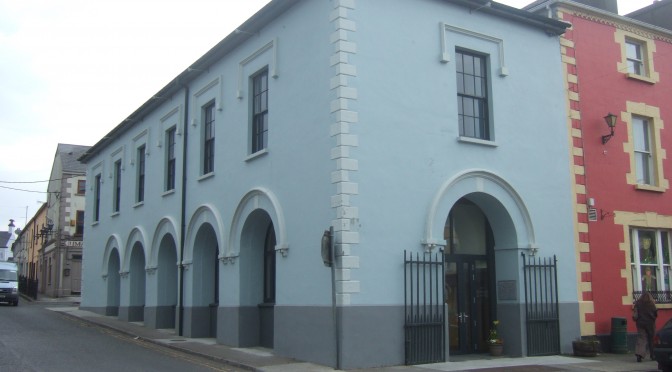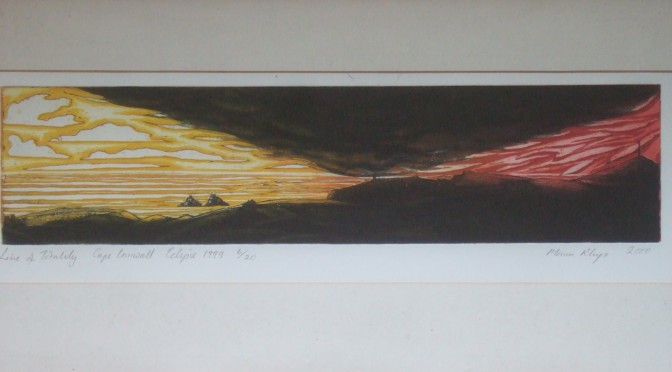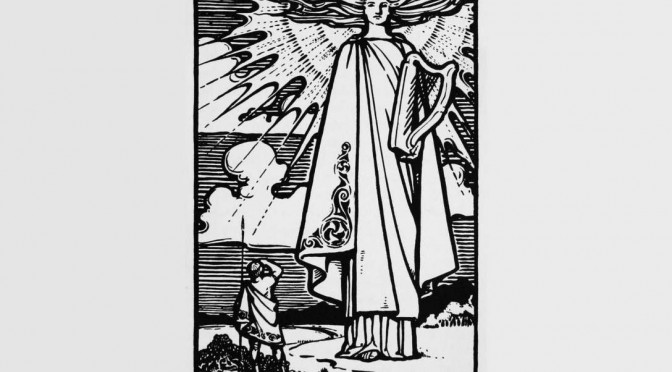Bha mi anns Uachtar Ard an dè airson an éiclips. Bha e latha gu math. I enjoyed seeing the eclipse and we had fantastic viewing weather all through the maximum, with clouds suddenly covering the sky about 3/4 of the way through.
Tag: Ireland
St Patrick’s Day in Ireland
Yesterday I passed through Granard, and stopped for a very touristy photo-opportunity at the Market House, where the Granard Balls were held in the 1780s, which gathered together the last of the old Irish harpers.
Eclipse
I am looking forward to the eclipse a week today!
Aonghus Mac ind Óg ⁊ an tiompán
As part of a big push to re-do my stringing paper at earlygaelicharp.info, I was searching for the reference to the tiompán with strings of “ór dearg” (red gold), which Ann Heymann refers to in her article Strings of Gold.
I was pleased when I finally tracked it down, to find that the person holding the instrument is Aonghus, son of Boann and the Dagda, who lived in Newgrange, at Brú na Bóinne. This is the same Aonghus an Bhroga referred to in the praise poem to Aonghas Òig, Rì Innse Gall, which I was working on last year.
Picts & Saxons in early medieval Ireland
I was reading the descriptions of people’s appearance in Togail Bruidne Dá Derga (The destruction of Daderga’s hostel), an early medieval Irish story from the Ulster Cycle, when I was interested to note these quite vivid descriptions of people at the court of the Irish High King, Conaire Mór mac Eterscél, who is said to have reigned in the first century BC or AD.
Scoil na gCláirseach
I have not posted for a while because I my time has been largely taken up with preparations for Scoil na gCláirseach next month.
As well as corresponding with attendees, and dealing with the hydra-like timetable, trying to corral all the different tutors, speakers and other events into some kind of order, I have been preparing for my own presentations.
This year, as usual I am leading the ever-popular field trip, where we visit all of the historical Irish harps in Dublin museums, and also presenting the very challenging one-hour overview of the entire tradition. This is pretty tough, trying to boil down everything to its essence. I have been working on a new handout, a kind of map or venn-diagram of the repertory, trying to illustrate the nature of the core repertory and peripheral stuff, and to categorise the core repertory – I think that what survives is in some ways not at all representative of what was played in the old tradition.
I am also leading two specialist sessions. I am giving a presentation on my work researching the music and traditions of Raghnall Mac Ailein Òig, which should be a great opportunity for me to refine my ideas on him. I did some more digging on his journey to Achnacarry to visit Cameron of Locheil – I have still not managed to locate the River Sgaitheal, but I did enjoy a digression reading all about Glen Pean.
Also I will be chairing a seminar on the Cloyne harp; we will have two different chromatic Irish harps on site, so this seems a great opportunity to get everyone together to discuss this difficult and intriguing subject.
Prof. Fergus Kelly, Early Irish Music: An overview of the linguistic and documentary evidence
 Professor Fergus Kelly presented the 2013 Statutory Public Lecture of the School of Celtic Studies on Friday 15th November at 8pm, Thomas Davis Theatre, Arts Building, Trinity College Dublin.
Professor Fergus Kelly presented the 2013 Statutory Public Lecture of the School of Celtic Studies on Friday 15th November at 8pm, Thomas Davis Theatre, Arts Building, Trinity College Dublin.
You can now get a video of the entire one-hour lecture plus a PDF of the handout with lots of further reading references, from the DIAS website
The Lark in the Morning
Last week and this week and next week the theme for my Saturday afternoon harp class in Dundee is Christmas music. Early this morning I suddenly decided that the wren song tradition would be a fun thing to do today – I have worked on Bunting’s 1809 setting of the Wren song before with a student, so I knew it was a great tune to give the class. But I also wanted to work on the traditions behind the wren hunt and so I had a quick look round to remind myself.
Fintan Vallely’s Companion to Irish Traditional Music has a nice little article on the wren, with a lovely photo of wren boys in Dingle – I would guess the photo was pre-WW2, one of the boys has a fife and two have bodhrans (which gave me a chance to talk about that!). The article also included one verse of the wren song, which fits Bunting’s tune pretty well.
I checked in Donal O’Sullivan’s notes on the Bunting tunes, and he does go into a lot of detail on the wren hunt but I did not spend too much time following up his references this morning.
Looking online I got a couple of excellent references. I got the pointer of the cutty wren song in Herd’s Scots Songs of 1776 – google books provided me with facsimile pages and all of a sudden I remembered that I knew this song from 20 years back, so I walked round the house trying to remember how it went. Every so often a whole new section of the question and answer would pop back into my head. In the class I managed to sing it and some of them even joined in with the answer sections – great fun, and not often that I sing an old song dragged up out of the back of my mind like that.
But the most fun was seeing a reference to Liam Clancy’s 1953 recording of the wren song on the LP, The Lark in the Morning. I have a copy of this LP which I had for some reason never got round to playing much so I had the fun of finding the record, setting up the equipment and listening to his lively version of the wren. This is another song I know from way back (I have it on an old cassette tape of traditional British and Irish midwinter songs), and I was amused to hear him mentioning the town where he lived and also his mother by name in the song.
Of course this evening as the gear was out and the record propped up against the bookcase I sat down on the floor and listened to both sides. What a beautiful and moving set of performances. At times I laughed out loud, and at other times there was a tear in my eye.
Connemara
This week I was visiting harpmaker Natalie Surina in Oughterard. My photo shows the early morning mist rising between the hedgerows.
A German or Scandinavian harper in Ireland c.1800?
The front cover of Collette Moloney’s book, The Irish Music Manuscripts of Edward Bunting, an Introduction and Catalogue, published in 2000 by the Irish Traditional Music Archive, shows an oil painting of an elderly gentleman holding a harp.
The caption on the back of the book says “Front cover ‘A Portrait of a Harper’, Irish School, c. 1800 (formerly attributed to James Barry: courtesy National Gallery of Ireland)”.
So if we trust the art experts who give these very definitive sounding opinions, this is a portrait painted in Ireland by an Irish artist about the year 1800. But who is the harpist?
I long ago recognised that the harp in the painting is of a type known today as a ‘Bohemian harp’, it is a type of instrument that was native to Germany but was also widely used in Scandinavia. The most diagnostic part of the harp really in this painting is the little soundholes arranged in a cross shape. But other aspects of it – the general shape of the instrument, the pale soundboard compared to the dark wood of the rest of the instrument, (not to mention the very un-Irish right hand treble) all indicate it is a German or Scandinavian harp of the late 18th century.
(Once I realised it was a German or Scandinavian harp in the picture, I started thinking that the man’s face looked quite Germanic as well).
Just this week I was looking at the online facsimiles of the Journal of the Folk Song Society of Ireland (more info on my Bunting mss page) and I noticed, in an article about Samuel Fergusson (vol vii p.11), a mention of the Swedish harpist Herr Sjoden, who visited Ireland in 1879.
I have not yet found a portait of Adolf Sjödén (1843-1893) for comparison – could he be our man I wonder?








